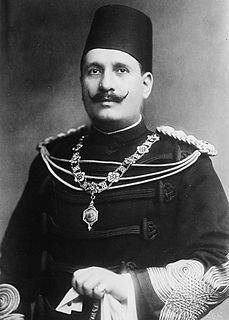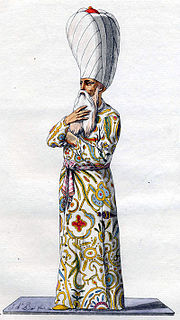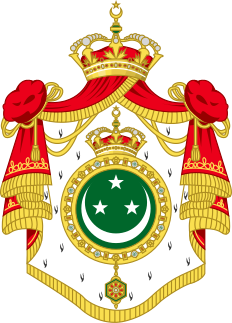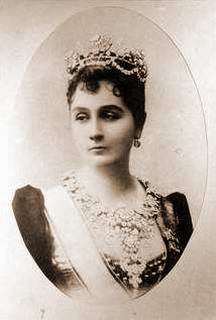


- Muhammad Abdul Moneim, Prince Regent of Egypt and the Sudan (1899-1979)
- (4) Prince Abbas Hilmi (born 1941)
- (5) Prince Daoud Abdul-Moneim (born 1979)
- (4) Prince Abbas Hilmi (born 1941)
- Muhammad Abdul Moneim, Prince Regent of Egypt and the Sudan (1899-1979)




- (1) Muhammad Ali, Prince of the Sa'id (born 1979)
- (2) Prince Fuad Zaher (born 2017) [4]
- (3) Prince Fakhr ud-din (born 1987) [ citation needed ]
- (1) Muhammad Ali, Prince of the Sa'id (born 1979)
Line of succession in June 1953



- (2) Muhammad Abdul Moneim, Prince Regent of Egypt and the Sudan (born 1899)
- (3) Prince Abbas Hilmi (born 1941)
- (2) Muhammad Abdul Moneim, Prince Regent of Egypt and the Sudan (born 1899)
- (1) Prince Mohammed Ali Tewfik (born 1875)

- Prince Hassan Ismail (1854-1888)
- Prince Aziz Hassan (1873-1925)
- (4) Prince Ismail Aziz Hassan (born 1918)
- (5) Prince Hassan Aziz Hassan (born 1924)
- Prince Muhammad Ali Hassan (1884-1945)
- (6) Prince Muhammad Iz ud-din Hassan (born 1914)
- (7)Nabil Ismail Izzat Hassan (born 1920)
- Prince Aziz Hassan (1873-1925)



Related Research Articles
Abbas II Helmy Bey was the last Khedive of Egypt and Sudan, ruling from 8 January 1892 to 19 December 1914. In 1914, after the Ottoman Empire joined the Central Powers in World War I, the nationalist Khedive was removed by the British, then ruling Egypt, in favor of his more pro-British uncle, Hussein Kamel, marking the de jure end of Egypt's four-century era as a province of the Ottoman Empire, which had begun in 1517.

Fuad I was the sultan and later king of Egypt and Sudan, sovereign of Nubia, Kordofan, and Darfur. The ninth ruler of Egypt and Sudan from the Muhammad Ali dynasty, he became sultan in 1917, succeeding his elder brother Hussein Kamel. He substituted the title of king for sultan when the United Kingdom recognised Egyptian independence in 1922.

Khedive was an honorific title of Persian origin used for the sultans and grand viziers of the Ottoman Empire, but most famously for the viceroy of Egypt from 1805 to 1914.

Sultan of Egypt was the status held by the rulers of Egypt after the establishment of the Ayyubid dynasty of Saladin in 1174 until the Ottoman conquest of Egypt in 1517. Though the extent of the Egyptian Sultanate ebbed and flowed, it generally included Sham and Hejaz, with the consequence that the Ayyubid and later Mamluk sultans were also regarded as the Sultans of Syria. From 1914, the title was once again used by the heads of the Muhammad Ali dynasty of Egypt and Sudan, later being replaced by the title of King of Egypt and Sudan in 1922.

Damat Prince Muhammad Abdel Moneim Beyefendi was an Egyptian prince and former heir apparent to the throne of Egypt and Sudan from 1899 to 1914. Upon the abdication of King Farouk following the Egyptian Revolution of 1952, he served as Regent for King Ahmed Fuad II until the declaration of the Republic of Egypt and abolition of the Egyptian and Sudanese monarchy in 1953.

Al-Rifa'i Mosque is located in Midan al-Qal'a, adjacent to the Cairo Citadel. Now, it is also the royal mausoleum of Muhammad Ali's family. The building is located opposite the Mosque-Madrassa of Sultan Hassan, which dates from around 1361, and was architecturally conceived as a complement to the older structure. This was part of a vast campaign by the 19th century rulers of Egypt to both associate themselves with the perceived glory of earlier periods in Egypt's Islamic history and modernize the city. The mosque was constructed next to two large public squares and off of several European style boulevards constructed around the same time.

Sultan Hussein Kamel was the Sultan of Egypt from 19 December 1914 to 9 October 1917, during the British protectorate over Egypt. He was the first person to hold the title of Sultan of Egypt since the killing of Sultan Tuman II by the Ottomans in 1517 following their conquest of Egypt.

The Muhammad Ali dynasty was the ruling dynasty of Egypt and Sudan from the 19th to the mid-20th century. It is named after its progenitor, Muhammad Ali Pasha, regarded as the founder of modern Egypt. It was also more formally known as the Alawiyya dynasty. Because a majority of the rulers from this dynasty bore the title khedive, it was often referred to by contemporaries as the Khedival dynasty.

Aziz Ezzat Pasha was an Egyptian politician.
Regencies in Egypt date back to Pharaonic times. Throughout Egypt's long history, there have been several instances of regents assuming power due to the reigning monarch's minority, physical illness or poor mental health. There have also been several cases of coregencies where two monarchs ruled simultaneously.

The Khedivate of Egypt was an autonomous tributary state of the Ottoman Empire, established and ruled by the Muhammad Ali Dynasty following the defeat and expulsion of Napoleon Bonaparte's forces which brought an end to the short-lived French occupation of Lower Egypt. The Khedivate of Egypt had also expanded to control present-day Sudan, South Sudan, Israel, Lebanon, Jordan, Syria, southern Turkey, and northwestern Saudi Arabia.

Melek Hassan Tourhan was the second wife of Sultan Hussein Kamel of Egypt. After her husband ascended the throne in 1914, she became known as Sultana Melek.
Prince Abbas Hilmi bin Prince Muhammad Abdel Moneim bin Khedive Abbas Hilmi II Bey is an Egyptian and Imperial Ottoman prince and financial manager. A member of the Muhammad Ali Dynasty and the Imperial House of Osman, he is the only son of Prince Muhammad Abdel Moneim and his Ottoman wife Princess Neslişah, and grandson of Khedive Abbas Hilmi II Bey.

Emina Ilhamy, also Amina Ilhami, was an Egyptian princess, and a member of the Muhammad Ali Dynasty. She was the first Khediva of Egypt from 1879 to 1892 as the wife of Khedive Tewfik Pasha, and Walida Pasha to their son Khedive Abbas Hilmi II Pasha from 1892 to 1914.
Nur Felek Qadin, was a consort of Isma'il Pasha of Egypt.
References
- ↑ Montgomery-Massingberd 1980, p. 35
- ↑ Rizk, Yunan Labib (10–16 February 2000). "The fallen dynasty". Al-Ahram Weekly . A Diwan of contemporary life, 324 (468). Archived from the original on 20 July 2008. Retrieved 2010-10-09.
- ↑ Cabinet of the Grand Chamberlain of the Kingdom of Egypt (1947). "Membres de la Famille Royale dans l'ordre de leur parenté avec Sa Majesté le Roi" [Members of the Royal Family by their degree of proximity to His Majesty the King]. Protocole (in French). Cairo: National Printing House. p. 22. OCLC 2482348.